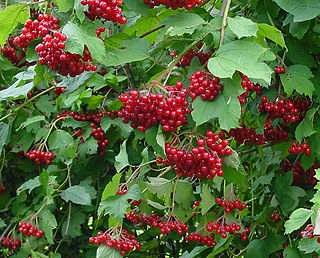
Viburnum is a genus of about 150–175 species of flowering plants in the moschatel family Adoxaceae. Its current classification is based on molecular phylogeny. It was previously included in the honeysuckle family Caprifoliaceae.

Viburnum lentago, the nannyberry, sheepberry, or sweet viburnum, is a species of Viburnum native to North America.
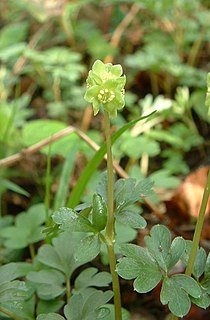
Adoxaceae, commonly known as moschatel family, is a small family of flowering plants in the order Dipsacales, now consisting of five genera and about 150–200 species. They are characterised by opposite toothed leaves, small five- or, more rarely, four-petalled flowers in cymose inflorescences, and the fruit being a drupe. They are thus similar to many Cornaceae.

The University of Delaware Botanic Gardens are botanical gardens and an arboretum located on the campus of the University of Delaware, in Newark, Delaware, United States. The gardens are open to the public without charge.
Snowball bush is a common name for several ornamental plants which produce large clusters of white flowers and may refer to:

Viburnum opulus is a species of flowering plant in the family Adoxaceae native to Europe, northern Africa and central Asia.
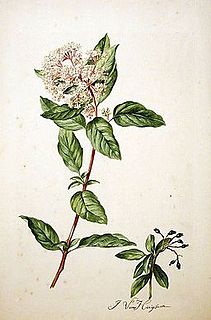
Viburnum tinus, the laurustinus, laurustine or laurestine, is a species of flowering plant in the family Adoxaceae, native to the Mediterranean area of Europe and North Africa. Laurus signifies the leaves' similarities to bay laurel.

Viburnum acerifolium, the mapleleaf viburnum, maple-leaved arrowwood or dockmackie, is a species of Viburnum, native to eastern North America from southwestern Quebec and Ontario south to northern Florida and eastern Texas. It is adapted for USDA hardiness zones of 4 to 8.

Viburnum lantana, the wayfarer or wayfaring tree, is a species of Viburnum, native to central, southern and western Europe, northwest Africa, and southwestern Asia. The vigorous deciduous European treelike shrub is common along waysides.

Viburnum trilobum is a species of Viburnum native to northern North America, from Newfoundland west to British Columbia, south to Washington state and east to northern Virginia. It is very closely related to the European and Asian Viburnum opulus, and is often treated as a variety of it, as Viburnum opulus L. var. americanum Ait., or as a subspecies, Viburnum opulus subsp. trilobum (Marshall) Clausen.

Viburnum plicatum is a species of flowering plant in the family Adoxaceae, native to mainland China, Korea, Japan, and Taiwan. The Latin specific epithet plicatum means “pleated”, referring to the texture of the leaves.

Viburnum nudum is a deciduous shrub in the genus Viburnum within the muskroot family, Adoxaceae.
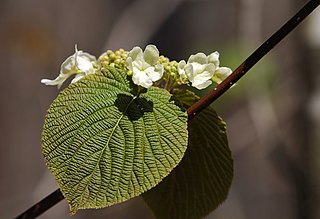
Viburnum lantanoides is a perennial shrub of the family Adoxaceae, growing 2–4 meters (6–12 ft) high with pendulous branches that take root where they touch the ground. These rooted branches form obstacles which easily trip walkers – hence the common name.

Viburnum edule, the squashberry, mooseberry, moosewood viburnum, highbush cranberry, or lowbush cranberry is a species of shrub native to Canada and the northern parts of the US.
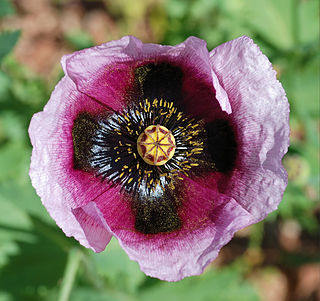
Papaver setigerum, common name poppy of Troy or dwarf breadseed poppy, is a herbaceous annual plant of the family Papaveraceae.
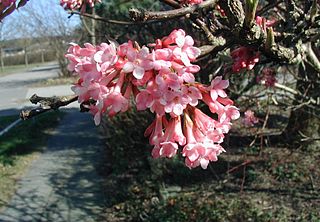
Viburnum farreri is a species of flowering plant in the family Adoxaceae native to northern China. Growing to 3 m (10 ft) tall by 2.5 m (8 ft) broad, it is an erect deciduous shrub with sweetly perfumed, pink-tinged white blooms in late autumn and early spring. Its dark green leaves are bronze when young, turning brilliant shades of red-purple in autumn. V. farreri grows in moist but well-drained soil in sun or partial shade.
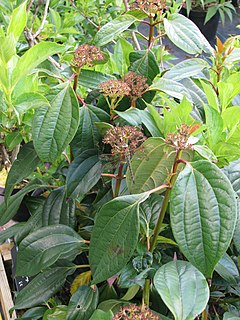
Viburnum cinnamomifolium, the cinnamon-leaved viburnum, is a species of flowering plant in the family Adoxaceae, native to western China. Growing to 5 m (16 ft) tall and broad, it is a substantial evergreen shrub with large, triple-veined, glossy, oval leaves up to 15 cm (6 in) long. Round clusters of tiny white flowers are produced in late spring, followed in late summer and autumn by oval black fruits.

Viburnum davidii, the David viburnum) is a species of flowering plant in the family Adoxaceae native to western China. Growing to 1.5 m (5 ft) tall and broad, it is an evergreen shrub with large, glossy, oval leaves up to 15 cm (6 in) long. Each leaf is deeply veined lengthwise with three curved lines. Round clusters of tiny white flowers are produced in late spring, followed in late summer and autumn by oval blue fruits. Both male and female plants are required to produce fruit.

Viburnum dilatatum, commonly known as linden arrowwood or linden viburnum, is a deciduous shrub in the moschatel family (Adoxaceae). It is native to eastern Asia, and can be found as an introduced plant in the mid-Atlantic regions in the U.S from New York to Virginia. Linden arrowwood is known for the clusters of red drupes it produces when it is mature.

Viburnum macrocephalum, common name Chinese snowball, is a species of flowering plant in the family Adoxaceae, native to mainland China. Its fertile form, Viburnum macrocephalum f. keteleeri, is of great cultural significance in China.



















